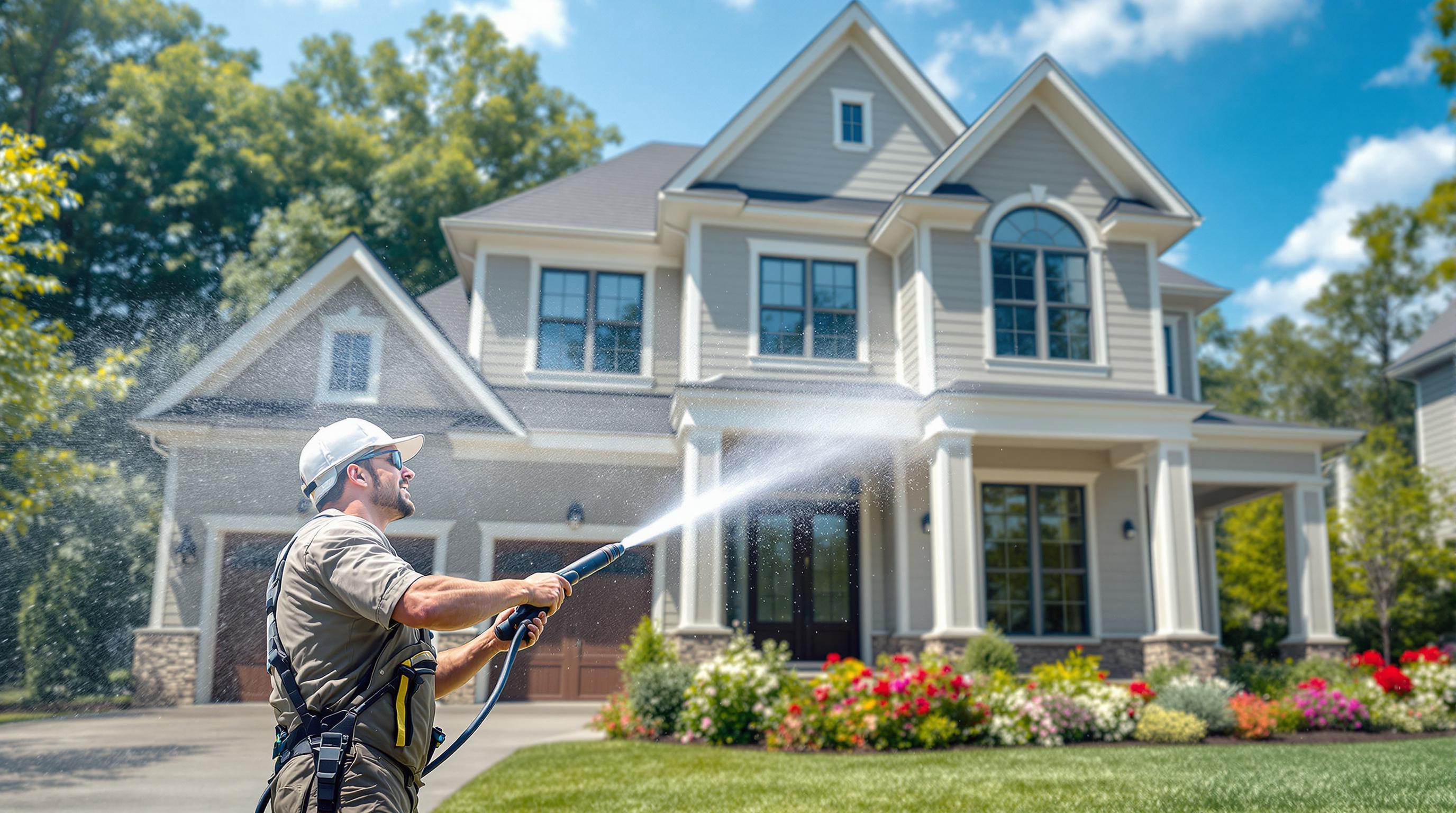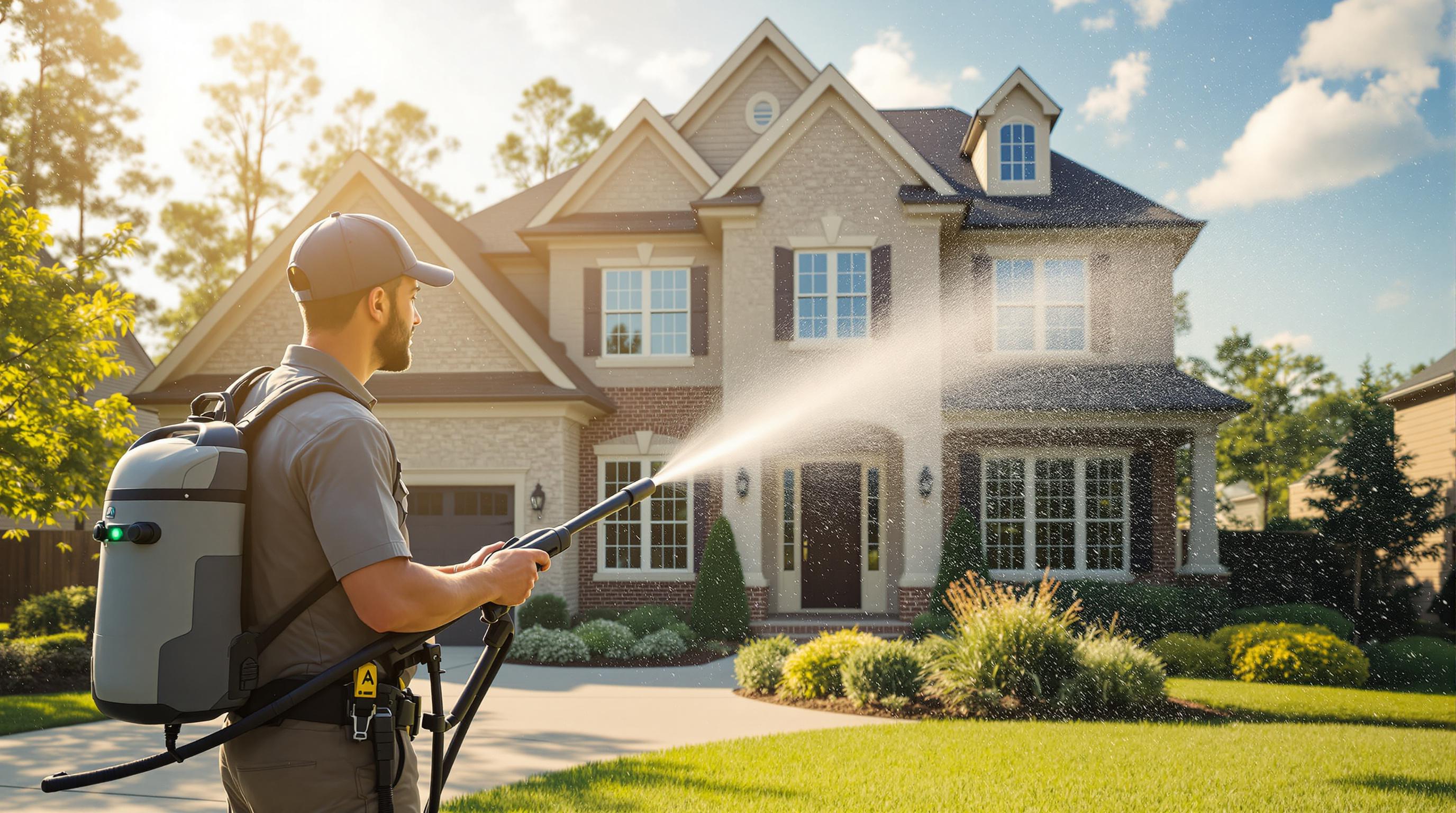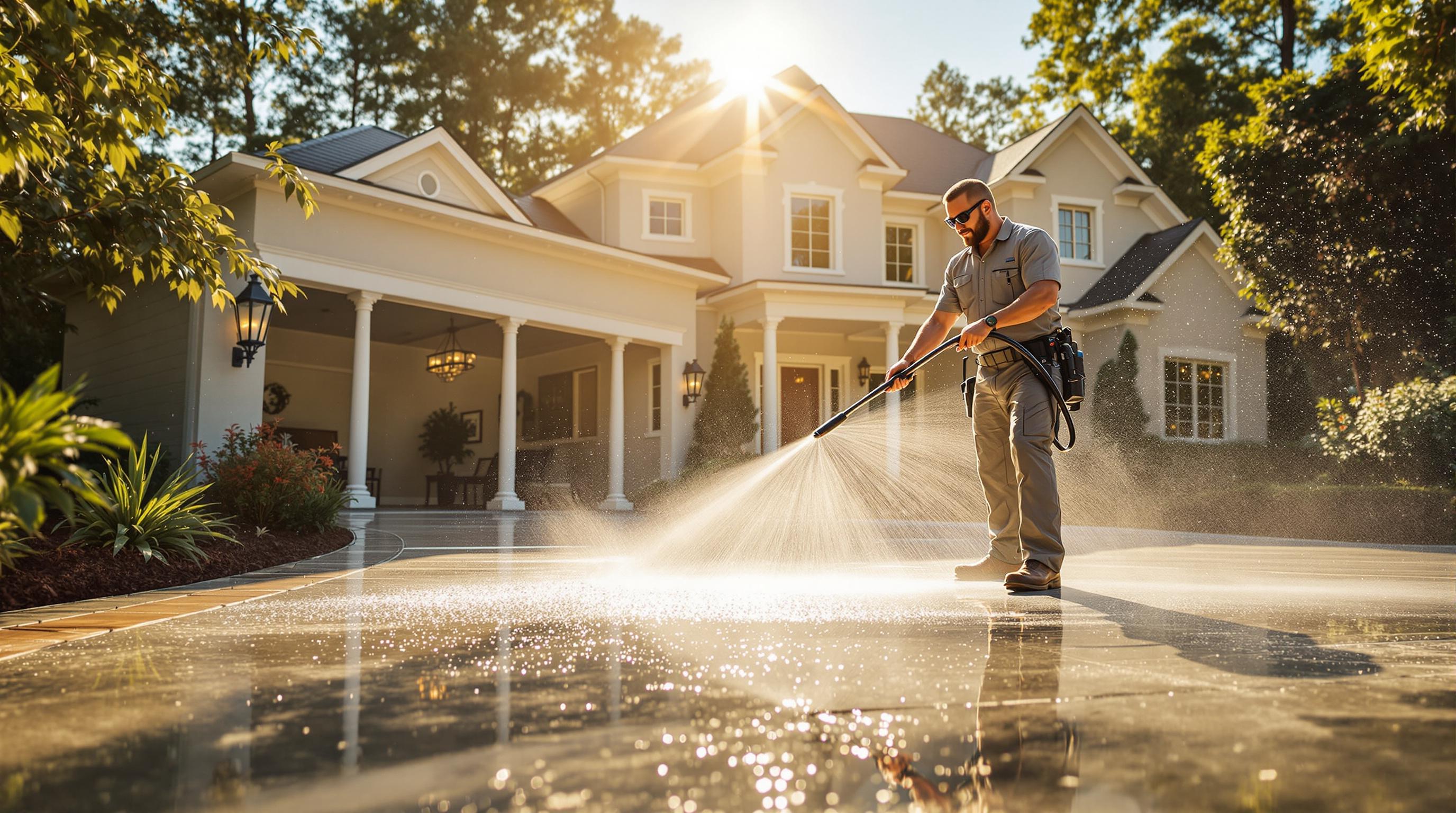Before pressure washing, inspect your home for damage to avoid making existing problems worse. High-pressure water can exacerbate issues like cracks, loose materials, or mold, leading to costly repairs. Here's a quick checklist of what to look for:
- Siding: Cracks, gaps, peeling paint, or bent panels.
- Deck: Splinters, loose hardware, or wood rot.
- Roof: Missing, cracked, or worn shingles.
- Concrete: Cracks, scaling, or surface erosion.
- Standing Water: Poor drainage around foundations or hardscaped areas.
Address these issues first to ensure safe and effective cleaning. For severe damage, consult professionals to prevent further harm.
Do This Before Every Pressure Washing Job (Pre Inspection ...
1. Siding Cracks and Gaps
Cracks and gaps in your siding are signs of damage that need to be addressed before pressure washing. Even small issues - like hairline cracks (around 1/16 inch) or gaps nearing 1/8 inch - can worsen under high pressure, potentially leading to water damage.
Where to Check for Cracks and Gaps:
- Around windows and doors
- At siding panel joints
- Near corner trim pieces
- Below rooflines
- Around utility openings
How to Spot Problem Areas:
- Walk around your home during bright daylight.
- Look for panels pulling apart or separating.
- Check for warped edges that don’t sit flat.
- Inspect areas where different materials meet.
These steps can help you catch damage early and decide if repairs are needed.
Signs That Demand Immediate Attention:
- Daylight visible through siding joints
- Loose or rattling siding panels
- Gaps wider than 1/16 inch
- Cracked or split vinyl siding
- Missing or damaged caulking
If you notice cracks, seal them with exterior caulking. Make sure vinyl siding panels are locked and secured properly.
Pressure Settings by Material:
Different siding materials handle pressure washing differently. For vinyl siding, stick to lower pressure settings (1,300-1,800 PSI). Fiber cement siding can handle slightly higher settings (2,000-2,500 PSI). Using too much pressure on damaged siding can escalate minor issues into costly repairs.
2. Paint Coming Off
If you notice paint peeling or flaking, it often points to underlying issues that pressure washing can make worse. The high-pressure water can strip away loose paint, leaving behind an uneven surface. Before cleaning, it's important to inspect these areas and address any needed repairs. This not only helps protect the surface underneath but also ensures a smoother, more uniform finish.
Experts at Pressure Washing Cary NC can provide advice on how to handle these repairs, ensuring your home is ready for a safe and effective exterior cleaning.
3. Mold on Siding
Mold on siding is a clear sign that the surface may be compromised and needs attention before any pressure washing begins. Dark spots, green patches, discoloration, and streaking often point to mold colonies that could damage the siding over time.
Signs of Mold on Siding:
- Black or green patches, commonly found in shaded areas
- Patchy discoloration
- Streaking running down the siding
- A musty smell near the affected areas
While pressure washing can clean surface mold, it’s important to check for underlying damage first. Skipping this step could make things worse - high-pressure water can push moisture and mold spores deeper behind the siding, spreading the problem.
When inspecting mold-affected siding, look for:
- Soft or deteriorating siding material
- Gaps or separations between panels
- Moisture buildup behind sections
- Signs of water seeping around windows or trim
For severe mold issues, bringing in a professional is the safest option. Experts, like the technicians at Pressure Washing Cary NC, assess the damage and determine the best cleaning method. They use customized techniques and adjustable pressure settings to safely remove mold while protecting your home’s exterior.
In more serious cases, a two-step process might be necessary: first, repairing or addressing structural issues, followed by a targeted pressure washing treatment. This approach ensures thorough mold removal without risking further damage to your siding.
4. Bent or Curved Siding
Bent or curved siding can indicate structural problems, which should be fixed before any pressure washing is done.
Signs to Watch For:
- Panels that appear warped or wavy
- Gaps forming between panels
- Sections pulling away from the house
- Uneven surfaces
- Buckling at seams
These issues, much like cracks or peeling paint, highlight the importance of inspecting your siding before cleaning.
What Causes Siding to Warp?
- Poor drainage leading to water damage
- Heat exposure causing material expansion
- Storm-related impact damage
- Natural wear and tear over time
- Incorrect or sloppy installation
Key Areas to Inspect:
- Edges: Run your hand along the edges to feel for looseness.
- Corners: Look for separation or warping in corner pieces.
- Wall Surface: Check from an angle to spot ripples or waves.
- Joints: Inspect for gaps forming between panels.
Pressure washing damaged siding can push water behind the panels, worsening the problem and potentially leading to mold or insulation issues. For severely bent sections, repairs or replacements are necessary before cleaning. Pressure Washing Cary NC technicians carefully evaluate the damage and adjust cleaning techniques to avoid further harm.
5. Deck Wood Splinters
Splinters on your deck are a clear sign of surface wear and tear, and pressure washing can make the problem worse. Tackling these issues beforehand helps preserve your deck's condition.
Common Signs of Splinters
- Raised fibers you can feel along the boards
- Long, thin pieces of wood peeling away
- Fraying or peeling edges on the boards
- Gray or white areas where fibers are lifting
Why Splinters Are a Problem
Pressure washing can worsen damaged wood by forcing water into the fibers or tearing away loose pieces. Here's what can happen:
- Moisture gets pushed deeper into the wood
- Loose splinters are ripped off entirely
- Partially split areas develop larger cracks
- Weakened sections of wood may be stripped away
Areas to Inspect Closely
Board Ends: These are especially prone to splintering because they absorb more moisture. Pay attention to:
- Ends of boards near steps
- Areas around posts and connections
- Spots where boards meet the house
High-Traffic Zones: These areas tend to wear out faster due to frequent use:
- Main walkways
- Around seating areas
- Entry and exit points
Preparing Before Pressure Washing
Before cleaning your deck, take these steps to handle splinters:
- Sand and brush away loose fibers using 80-grit sandpaper and a stiff brush
- Apply wood hardener to heavily damaged spots
- Let treated areas cure for 24-48 hours
Pressure Washing Cary NC suggests completing these steps at least two days before cleaning. This ensures your deck is ready for safe and effective pressure washing.
Surface Condition and Action Guide
| Condition | Risk Level | Action Needed |
|---|---|---|
| Minor splinters | Low | Light sanding |
| Visible wood separation | Medium | Sand and seal |
| Deep cracks | High | Get professional repairs |
| Structural damage | Critical | Replace the board |
Taking care of splinters ahead of time not only protects your deck but also ensures a better, longer-lasting cleaning outcome.
6. Deck Hardware Issues
Loose or rusted screws, nails, and bolts can become even worse when exposed to high-pressure water. This not only weakens the deck’s structure but also creates safety risks. Plus, rusted hardware can leave unsightly stains on the deck surface.
After checking for surface wear, turn your attention to the hardware. Look for any loose or corroded fasteners before you start cleaning. According to Pressure Washing Cary NC, it’s important to fix these issues right away to prevent further damage and ensure safe cleaning. If you find damaged hardware, replace or repair it to protect both the fasteners and the deck itself.
sbb-itb-8e2a680
7. Deck Wood Rot
Wood rot can compromise the strength of your deck, and pressure washing may make the problem worse. Catching it early helps maintain safety and prevents further damage.
Where to Look for Wood Rot:
- Support posts and beams
- Areas where wood touches the ground
- Around railings and stairs
- Near planters or spots with standing water
- Corners and joints where moisture collects
To check for rot, use a screwdriver to probe areas that seem suspicious. Watch for soft or spongy wood, dark stains, or a musty smell - these are all signs of decay.
According to Pressure Washing Cary NC, inspecting your deck thoroughly is essential. If you find severe rot, repairs or replacements are necessary before pressure washing, as the process can worsen the damage.
How to Confirm Rot:
- Probe with a flathead screwdriver in suspect areas.
- Check for darker discoloration compared to surrounding wood.
- Look for crumbling or unusual textures.
- Focus on spots where water tends to pool.
Small soft spots could hide more extensive damage. If the signs are widespread, it’s best to consult a professional for a detailed assessment.
8. Roof Shingle Problems
Before pressure washing, take time to inspect your roof shingles for any damage. This step is crucial to avoid making existing issues worse.
Key Issues to Look For:
- Missing Shingles: Bare spots or gaps can allow water to enter your home.
- Curled Edges: Shingles with curled edges can let water seep underneath, increasing the chance of leaks.
- Cracked Shingles: Even small cracks or splits, especially near roof penetrations, can expand under pressure washing.
If you notice any serious damage, make repairs beforehand to prevent water from seeping into your roof.
Additional Safety Checks
Don’t stop at just the shingles. Be sure to inspect these areas as well:
- Where roof sections meet, such as valleys.
- Around roof penetrations like vents, pipes, or chimneys.
- The edges and corners of your roof.
- Areas with heavy moss growth or constant shade.
Taking the time for a detailed inspection helps ensure your roof is ready for pressure washing without risking further damage.
9. Shingle Surface Wear
Even minor shingle wear can get worse if exposed to high-pressure water, making a thorough pre-cleaning inspection a must.
Black Streaks and Staining
Dark streaks on your roof are often signs of algae growth and surface damage. These marks not only affect your roof's appearance but also signal that the shingles might be compromised. As Tommy M. shared after using a proper cleaning method:
"Soft washing our roof and it looks all the better now. All those unsightly black streaks that were on our roof are completely gone! Very happy and satisfied! Thanks!"
This highlights the importance of using a gentler cleaning approach to protect your roof.
Safe Cleaning Approach
High-pressure washing can be too harsh for shingles that show signs of wear. A better option is soft washing - a low-pressure cleaning method designed to be more delicate. Before cleaning, have a professional check the condition of your shingles to see if repairs or replacements are needed. For expert advice and safe cleaning services, you can reach out to Pressure Washing Cary NC (https://pressurewashingcarync.com).
10. Concrete Surface Damage
Before starting any pressure washing, take a close look at the concrete for signs of damage. Here's what to check:
Surface Scaling
Surface scaling happens when the top layer of concrete peels away, leaving shallow depressions between 1/8 and 1/2 inch deep. If you spot scaling, address the root cause before using high-pressure water to avoid making the problem worse.
Cracks and Spalling
Pay attention to cracks and areas where concrete is breaking apart. Key signs include:
- Cracks wider than 1/8 inch
- Patterns of multiple cracks
- Loose pieces of concrete
- Exposed aggregate or reinforcing steel
Surface Erosion
Check for areas with a worn or uneven texture, pitted surfaces, or exposed aggregate.
Moisture Problems
Dark, damp spots or standing water can signal drainage issues. Pressure washing in these areas could make things worse.
If you see any of these issues, it's a good idea to consult a professional. For those in Cary, NC, Pressure Washing Cary NC can help determine the safest cleaning pressure and method.
11. Driveway Surface Wear
When checking your driveway, pay close attention to these areas:
Oil and Chemical Stains
Look for stains caused by oil or chemicals. Dark, persistent stains can hint at deeper issues and may require specific cleaning techniques to avoid further damage.
Surface Raveling
Check for signs of surface wear, such as:
- Loose stones scattered across the driveway
- A rough or uneven texture
- Shallow dips caused by material loss
Joint Deterioration
Examine the joints in your concrete driveway. Signs of trouble include crumbling material, widening gaps, weeds growing in the seams, or water pooling along the edges.
Edge Damage
Inspect the edges where your driveway meets landscaping. Crumbling or damaged edges need repairs, as pressure washing can worsen the problem. Adjust cleaning methods accordingly to prevent further harm.
Surface Sealer Condition
Assess the condition of the surface sealer. If it’s peeling, flaking, or worn away in certain spots, reapplication may be necessary before cleaning.
Depending on these conditions, standard pressure washing techniques might need to be adjusted. For specialized care and expert cleaning tailored to your driveway's needs, reach out to Pressure Washing Cary NC. Their team is skilled in protecting and maintaining your outdoor surfaces.
12. Standing Water Issues
Standing water is often a sign of drainage problems that need to be fixed before pressure washing.
Foundation Areas
Inspect the area around your home's foundation for water pooling within 10 feet. This may point to issues like improper grading, clogged drainage systems, or compacted soil preventing proper water absorption. Pressure washing in these conditions can push water into weak spots, potentially worsening foundation damage.
Also, take a look at hardscaped areas for similar low-lying spots that could add to water-related concerns.
Low Spots in Hardscaping
Check concrete surfaces for dips or depressions where water tends to collect. These areas might indicate settling, structural issues, or mistakes during installation.
Deck and Porch Areas
Look at decks and porches for signs of poor drainage. Watch for water pooling on the boards, moisture trapped between them, or water building up around the posts.
Landscaping Drainage
Pay attention to areas where soil stays wet for extended periods or where water gathers near downspouts or mulch beds.
Fixing drainage concerns is just as important as inspecting siding or decks. Address these problems before pressure washing to avoid causing more damage to your property. Taking care of drainage issues first ensures the cleaning process can be done safely and effectively.
If you're unsure about drainage or surface preparation, reach out to the experts at Pressure Washing Cary NC. Their team can help make sure your home is ready for pressure washing while protecting all exterior surfaces.
Wrapping Things Up
Inspecting siding, roofs, and other surfaces before cleaning is key to avoiding unnecessary damage. Spotting issues early can save you from unexpected repair costs down the line.
Hiring professionals for pressure washing ensures the job is done right. Their expertise brings several advantages, including:
- Detailed surface evaluations to determine the best cleaning approach
- Specialized tools designed for various materials
- Controlled pressure settings to avoid surface damage
- Safe treatments for existing problems
- Proven methods that improve both the look and lifespan of your surfaces
Whether it's cracked siding, rotted wood, or drainage concerns, tackling these problems beforehand sets the stage for a successful cleaning.
"I have never been so impressed with a company. They arrived early, did exactly what they said they were going to do, and I couldn't be more pleased. Their prices were awesome, and the work was so good my neighbors have come out and asked for cards. I guess that says it all." - Carolyn C., Review of Matthew's Exterior Services
Choosing professional services not only ensures a deeper clean but also helps protect delicate surfaces from further harm.
For expert evaluations and cleaning solutions that safeguard your property, reach out to Pressure Washing Cary NC today.


